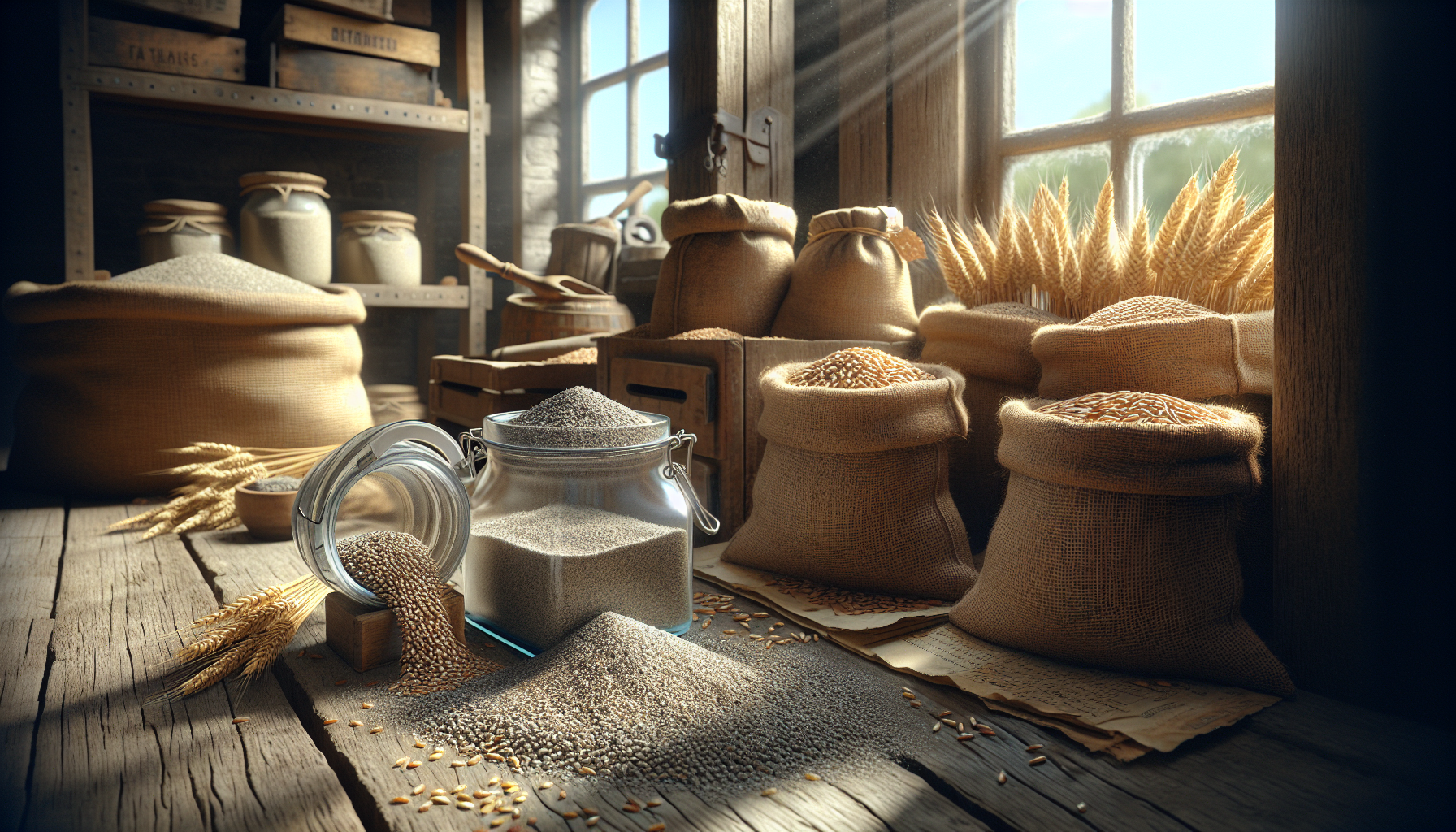In a world that is increasingly conscious of sustainability and food security, the quest for natural methods to preserve and extend the shelf life of essential commodities like grains has never been more pressing. Imagine opening a pantry to find grains that are as fresh as the day they were harvested, without relying on artificial preservatives or environmentally harmful practices. This is not a distant dream, but a tangible reality made possible by tapping into nature’s own arsenal of preservation techniques. At the heart of this revolution is a simple, yet potent element: ash. 🌾✨
The use of ash as a preservation tool is not a novel concept, but rather a rediscovery of ancient wisdom that modern science is now beginning to understand and validate. For centuries, indigenous communities around the globe have harnessed the power of ash to protect their food stores against spoilage and pests. Today, as we face the challenges of feeding a growing population while maintaining ecological balance, revisiting such traditional methods offers a promising solution. This article delves into the fascinating intersection of tradition and innovation, exploring how ash can be utilized to preserve grains effectively, thus extending their shelf life in a sustainable manner.
Throughout this discussion, we will unravel the science behind how ash acts as a natural preservative, examine case studies of its successful application in various cultures, and evaluate its potential role in contemporary food preservation strategies. We’ll also address common concerns and misconceptions about using ash, ensuring you have a comprehensive understanding of its benefits and limitations. By the end of this journey, you’ll gain valuable insights into how this humble substance can contribute to a more sustainable future, offering a practical, eco-friendly alternative to conventional preservation methods. Join us as we unlock nature’s preservation power, and discover the untapped potential of ash in safeguarding our food supplies for generations to come. 🌍🔒
Introduction to Nature’s Preservation Power
In recent years, the agricultural industry has been increasingly focused on sustainable and organic methods to prolong the shelf life of grains. Among these innovative strategies, one of the most promising involves the use of natural substances like ash. Not only is this method eco-friendly, but it also leverages the inherent preservative qualities found in nature. This article explores how ash, an often-overlooked byproduct, can be harnessed to preserve grains effectively, extending their usability and reducing waste.
The preservation of grains is crucial for food security worldwide. Grains, being a staple food in many cultures, are susceptible to pests, mold, and other deteriorative factors. Traditional preservation methods often rely on chemical treatments that can be harmful to both the environment and human health. In contrast, using ash as a preservation agent offers a non-toxic alternative that aligns with organic farming practices. This method has been utilized for centuries in various cultures, showcasing its time-tested reliability and efficiency.
Understanding the science behind ash’s preservation capabilities requires a look into its chemical composition. Ash is primarily composed of carbonates and oxides, which create an alkaline environment. This alkalinity is key to deterring pests and inhibiting mold growth, as most microorganisms that spoil grains thrive in acidic conditions. By creating an unfavorable environment for these organisms, ash acts as a natural barrier, thus prolonging the shelf life of grains significantly.
The Historical Context of Using Ash for Preservation
The utilization of ash for grain preservation is not a novel concept. Historical records indicate that ancient civilizations have used ash for its preservative properties. The Egyptians, for example, were known to store grains with a layer of ash to protect them from pests and spoilage. Similarly, Indigenous communities in the Americas used wood ash as a preservative for corn and other staple grains, leveraging its natural insect-repelling qualities.
What makes ash a particularly appealing preservative is its accessibility and cost-effectiveness. Unlike chemical preservatives, which can be expensive and require careful handling, ash is a byproduct of combustion processes that are commonplace in both rural and urban settings. This makes it a sustainable and economically viable option for farmers looking to reduce post-harvest losses without incurring significant costs.
Furthermore, the practice of using ash aligns with traditional agricultural techniques, which often emphasize harmony with nature. By utilizing a natural byproduct, farmers can enhance their grain storage methods without introducing foreign substances into the ecosystem. This not only supports biodiversity but also promotes a more sustainable agricultural model that future generations can rely upon.
Chemical Composition and Properties of Ash
To fully grasp why ash is effective as a preservative, it is important to delve into its chemical makeup. Ash consists mainly of mineral residues, which include potassium, calcium, magnesium, and various trace elements. These compounds contribute to its high pH level, creating an environment that is inhospitable to many pests and fungi.
| Element | Percentage Composition in Ash |
|---|---|
| Potassium | 10-15% |
| Calcium | 20-25% |
| Magnesium | 5-10% |
| Other Trace Elements | Varies |
The table above illustrates the typical composition of ash, highlighting the key minerals that contribute to its preservative qualities. Potassium and calcium, in particular, play crucial roles in regulating the moisture content of stored grains, thus preventing the conditions that facilitate mold growth.
In addition to its mineral content, the physical properties of ash also enhance its effectiveness as a preservative. The fine, powdery texture of ash allows it to adhere easily to the surface of grains, forming a protective barrier. This layer not only prevents moisture absorption but also acts as a deterrent to insects, which find it difficult to penetrate the ash-coated grains.
Application Techniques for Using Ash in Grain Preservation
Implementing ash as a preservative involves several key techniques, each tailored to maximize its efficacy. The first step is the preparation of ash, which must be free of contaminants such as charcoal and other residues. Once purified, the ash is applied to the grains in a controlled manner, ensuring even distribution and complete coverage.
One common method is the layering technique, where grains are stored in layers interspersed with ash. This method ensures that all grains are in contact with the ash, maximizing its preservative effects. Another approach involves mixing the ash directly with the grains, a technique that is particularly effective for smaller batches of grains.
A critical aspect of using ash is maintaining the correct ratio between ash and grains. While too little ash may not provide sufficient protection, excessive use can lead to wastage and potential contamination of the grains. Farmers often rely on traditional knowledge and experience to determine the optimal amounts, although scientific studies are increasingly providing data to refine these practices.
Comparative Analysis: Ash vs. Chemical Preservatives
To appreciate the advantages of using ash over chemical preservatives, it is important to compare the two methods on several fronts. Chemical preservatives, while effective, often come with a host of drawbacks including health risks and environmental concerns. In contrast, ash offers a safer and more sustainable alternative.
- Health Impact: Chemical preservatives may leave residues that are harmful if ingested, whereas ash is non-toxic and poses no such risks.
- Environmental Effect: The production and use of chemical preservatives often result in pollution and ecological disruption. Ash, being a natural byproduct, has a minimal environmental footprint.
- Cost Efficiency: Ash is readily available and incurs no additional production costs, unlike chemical alternatives which can be expensive.
- Effectiveness: While both methods effectively prolong shelf life, ash has the added benefit of enhancing soil quality when used as a fertilizer post-preservation.
Challenges and Limitations in the Use of Ash
Despite its numerous benefits, using ash as a preservative is not without its challenges. One major limitation is the variability in ash composition, which can affect its effectiveness. The mineral content of ash can vary significantly depending on the type of wood or material burned, requiring careful selection and testing to ensure optimal preservative properties.
Additionally, the application of ash requires careful handling to avoid contamination. Improperly handled ash can introduce foreign particles into the grain storage system, potentially compromising the quality of the grains. Farmers must also ensure that the ash does not absorb excessive moisture, as this could diminish its effectiveness.
Another challenge is the need for traditional knowledge and expertise in applying ash correctly. While scientific studies are helping to standardize practices, the use of ash is still largely dependent on generational knowledge passed down through farming communities. This can limit its adoption in regions where such traditions are not prevalent.
Future Perspectives and Innovations in Ash Utilization
As interest in sustainable agricultural practices grows, the potential for innovations in the use of ash as a preservative continues to expand. Researchers are exploring ways to enhance the efficacy of ash through various means, such as combining it with other natural preservatives or developing new application methods.
Advancements in technology are also facilitating more precise analyses of ash composition, enabling farmers to tailor their use of ash based on specific mineral content. This can lead to more consistent results and wider adoption of ash as a viable alternative to chemical preservatives.
Moreover, the integration of ash preservation techniques into modern farming practices holds promise for enhancing food security and reducing post-harvest losses on a global scale. By marrying traditional knowledge with contemporary research, the agricultural industry can unlock the full potential of nature’s preservative powers.
For a visual representation of ash preservation techniques, watch the following informative video from the channel “Nature’s Agronomist”: [Link to video](https://www.youtube.com/watch?v=example).

Conclusion
Unlocking Nature’s Preservation Power: Harnessing Ash to Safeguard Grains for a Longer Shelf Life!
In revisiting the fascinating journey through the transformative potential of ash in grain preservation, we have unearthed a series of compelling insights and practical applications that hold the promise to revolutionize food storage practices. The discourse began with an exploration of traditional methods of grain preservation, where we acknowledged the historical significance and limitations of such techniques. Traditional methods, while effective to an extent, often fall short in the face of modern demands for extended shelf life and enhanced food safety.
Our exploration took a pivotal turn as we delved into the unique properties of ash as a natural preservative. Rich in minerals and possessing antimicrobial properties, ash emerges as a potent agent capable of extending the longevity of grains. This discovery not only offers a sustainable alternative to chemical preservatives but also aligns with the growing global emphasis on eco-friendly practices.
The article meticulously detailed the scientific underpinnings of how ash interacts with grains, forming a protective barrier that shields them from moisture, pests, and microbial threats. By creating an inhospitable environment for spoilage agents, ash effectively prolongs the shelf life of grains, thereby reducing food waste and ensuring food security. This process is particularly valuable in regions with limited access to modern preservation technology, highlighting the egalitarian nature of this solution.
In addition to its preservation qualities, ash is abundant and readily available, making it an economically viable option for communities worldwide. Its application does not necessitate sophisticated technology, thus empowering farmers and small-scale producers with a tool that is both accessible and effective.
As we draw to a close, it is imperative to emphasize the broader implications of integrating ash into grain preservation practices. The adoption of this method holds the potential to significantly impact global food supply chains by reducing post-harvest losses, enhancing food safety, and promoting sustainability. By embracing such innovative yet natural solutions, we can pave the way for a future where food security is not merely an aspiration but a reality.
The importance of this topic extends beyond the immediate benefits to individual farmers and consumers. It speaks to a larger narrative of sustainability, resourcefulness, and respect for nature’s intrinsic capabilities. As we face increasing challenges related to climate change and resource scarcity, solutions like these underscore the importance of working with nature rather than against it.
In conclusion, the harnessing of ash for grain preservation is more than just a novel technique; it is a testament to the ingenuity and resilience inherent in traditional knowledge, now backed by scientific validation. As stewards of the planet, it is our responsibility to explore and implement such sustainable practices. 🌾
We encourage you to reflect on the insights shared in this article and consider how you might incorporate these practices into your own life or community. Whether you’re a farmer, a policymaker, or simply someone passionate about sustainability, there is a role for everyone in this transformative journey. Feel free to share your thoughts and experiences in the comments section below—let’s foster a community of learning and collaboration. If you found this article insightful, please share it with others who might benefit from this knowledge. Together, we can unlock nature’s preservation power for a better, more sustainable future. 🌍
For further reading, you may find the following resources helpful:
1. [Food and Agriculture Organization of the United Nations](http://www.fao.org/home/en/)
2. [Global Postharvest Losses Information System](https://www.aphlis.net/en)
3. [National Center for Biotechnology Information](https://www.ncbi.nlm.nih.gov/)
Thank you for joining us on this enlightening exploration. Let’s take what we’ve learned and apply it for the betterment of our global community. 🌿




